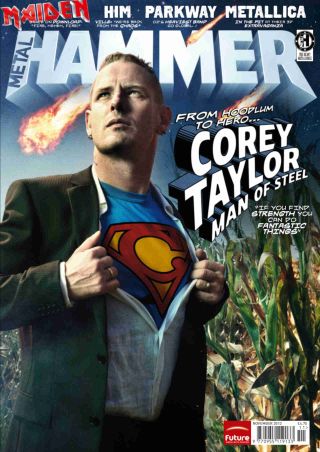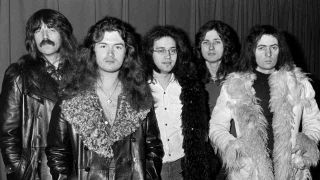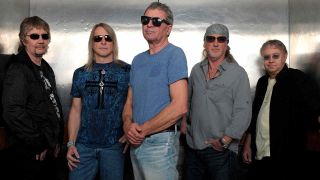Together with Black Sabbath and Led Zeppelin, Deep Purple had been the third within the holy trinity of bands who laid down the blueprint for arduous rock and heavy metallic within the late 60s and early 70s. In 2012, singer Ian Gillan and drummer Ian Paice seemed again on the band’s turbulent historical past, tangled household tree and typically missed legacy.
By the early Nineteen Seventies, the spiralling variety of music sub-genres led to completely different actions lining up over one another to enroll new recruits. No matter type of freak you had been, you had a house to coach you on which bands to hearken to and which medicine to take. Area-cases and acid goblins flocked to Pink Floyd. Black Sabbath attracted doomsday occultists, schoolyard burnouts and superior demonologists. Funky intercourse machines had James Brown. Tablet-shovelling biker pigs and sci-fi weirdos fell in with Blue Oyster Cult.
However what in regards to the less-conflicted youngsters of Woodstock? The beer-drinkers and hell-raisers, the clock-punching ham’n’eggers in soiled denim, dwelling for the weekend? What was the color of hoi polloi within the age of Aquarius? It was purple, brother. Deep Purple.
Whereas they had been by no means metallic within the scientific, goathorns and hellfire sense, Deep Purple had been all the time heavy, and received heavier alongside the best way, carving out a path of sonic extra that may spawn the New Wave Of British Heavy Steel and its tradition of headbanging true-believers.
If anybody band was accountable for ushering within the period of long-haired, ear-shattering, spectacle-creating Rock Gods, it was Deep Purple. With early-career smashes like Freeway Star, Pace King and Smoke On The Water – a tune so ingrained upon rock tradition that heavy metallic children can hum the signature riff within the womb – the band toured the world, pummelling audiences with thick slabs of groin thunder, establishing themselves because the preeminent emissaries of the brand new cosmic heavy.
Nonetheless, because the 70s wore on, the trimmings of success did their harm, and Deep Purple’s good rock’n’roll machine started to throw off Spinal Faucet-esque sparks. Ego wars, revolving-door lineups, betrayals, dangerous information, lean-times, dying and illness, all had been hurled into Purple’s thorny path because the many years rushed previous. And but, half a lifetime later, they’ve endured, freeway stars to the top.
“Consider it as a journey, an expedition,” says Ian Gillan, Deep Purple’s longest-running and best- recognized frontman. “We had been going someplace, and there was no map. We made it up as we went alongside.”
Gillan’s journey with Purple started in the summertime of 1969. The band had already been collectively for a 12 months, however after an preliminary brush with success, they had been stalling out. Their debut album, Shades Of Deep Purple, was launched in July 1968 and spawned a shock American hit with their cowl of Joe South’s Hush. Seizing the second, they toured the US with Cream and rushed out a second album, the spacey Ebook Of Taliesyn.
Whereas it bought respectfully within the US, it spawned no hits, so the band tried once more with 1969’s self-titled Deep Purple. They marked their first foray into heavier sounds. Wrapped in a nightmarish Bosch cowl, the ethereal acid- delica of ’68 was sloughed off in favour of tribal thumping and menacing riff-rock. Songs like Chasing Shadows and Hen Has Flown had been stark stabs of proto-metal bludgeon. It was clear that the band had discovered their route.

The album tanked, however the die was solid, and a rift developed inside Purple’s ranks. Guitarist Ritchie Blackmore, drummer Ian Paice and keyboard participant Jon Lord needed to proceed exploring the thick, fuzzy sounds of the brand new album; vocalist Rod Evans and bass participant Nick Simper weren‘t so prepared to embrace this new period of overkill. Inside months, they had been solid out into the wilderness. Simper went on to kind Warhorse; Evans moved to the US and joined space-metal freaks Captain Past. As for Purple correct, round that point they occurred to catch Ian Gillan’s pop-psyche band Episode Six, and out of the blue the clouds parted. Gillan and Episode Six bassist Roger Glover had been poached, and the hustle was on.
“We had some nice musicians,” explains Paice, Purple’s solely fixed member, “so there was by no means any query about our musicianship. What we didn’t have had been nice songwriters, which is what we received with Ian and Roger.”
“I believe my vary was a bit extra adventurous than Rod’s, let’s say,” says Gillan, “which is what they had been in search of. They needed to let free.”
After a few odd distractions – Gillan was recruited to document the a part of Jesus for the Jesus Christ Famous person album, and the entire band carried out with the Royal Philharmonic Orchestra – Purple’s revamped lineup hit the studio to document 1970’s In Rock. A watershed second in heavy rock historical past, it spawned two classics: the raucous, ramshackle Pace King, and the throbbing 10-minute stoner epic Youngster In Time. The album ultimately scraped the highest 5 rock charts within the UK, secured Purple’s place as heavy rock pioneers and propelled them right into a interval of unparalleled productiveness and success. However as Gillan explains, it actually didn’t really feel that means on the time.
“They didn’t wish to find out about us in England. We had been taking part in in the identical halls as we had been with Episode Six. Nothing from the primary three information, Hush or something, anybody in England. However we knew we had been on to one thing, so we stored at it.”
“It was an enormous leap into one other dimension, musically,” says Paice. “We had no thought if it’d achieve success, however it was nice enjoyable to play.”

The subsequent two years discovered Purple on a punishing schedule of relentless excursions and frequent journeys to the studio. Scorching on the heels of In Rock got here the proggy Fireball, their first document to hit the primary spot on the UK charts. Six months later, simply in time for Xmas 1971, Machine Head hit the bins, cementing Purple’s standing because the kings of 70s metallic. The album opened with the livid Freeway Star, nonetheless the final word road-dog anthem.
“We had been very prolific,” Gillan says of their early days. “Music was oozing out of us. We used to write down songs on our approach to gigs, and carry out them that night time. Freeway Star was one instance. Folks wouldn’t imagine it, however luckily we had a number of journalists on the bus. One among them requested, ‘How do you write the songs?’ and Ritchie began taking part in one notice on his guitar, as a joke. And I began singing, as we drove down the freeway. It wasn’t precisely the identical because it was on the bus, however we carried out it that night time in Portsmouth. That occurred so much.”
Machine Head boasted Smoke On The Water, too, a tune with maybe probably the most recognisable riff of all time. It was primarily based on an incident the band witnessed in Switzerland whereas they had been recording in a cellular studio. Frank Zappa and the Moms Of Invention had been taking part in a gig on the Montreux On line casino when an overzealous fan shot off a flare gun, beginning a hearth that burned the on line casino right down to the bottom. Purple watched the mayhem from the protection of their resort, with Roger Glover noting how the smoke snaked throughout Lake Geneva. This oddball ode to unintentional arson turned Purple’s largest hit, and shot Machine Head to the highest of the rock charts everywhere in the world.
“Smoke… was a seven-minute tune. It by no means received performed on any radio station, anyplace on this planet, till somebody at Warner Brothers thought they may do an edit. It didn’t do something in any respect to the tune, aside from make it worse,” chuckles Gillan. “The edit adopted the principles of the radio, and it turned successful.”
1972 was one other action-packed 12 months for Deep Purple. After a very punishing gig on the London Rainbow Theater, Purple was recognised because the loudest band on this planet by the Guinness Ebook Of World Data, an enviable honour for any arduous rock band.
“The Who had been in all probability louder,” admits Paice. “We had been simply the primary to have meters to document our quantity ranges. Nonetheless, you wanted one thing to stay out these days, and loud labored.”
In August, they launched the double-live Made In Japan album. With seven songs spanning 4 sides, it illuminated the jammy features of Purple’s gigs, the flash of Blackmore’s guitar heroics, and the tribal cosmic funk of the band’s backline. Extra importantly, it revealed the worldwide enchantment of the band, and why their music resonated so deeply with so many individuals.
Purple weren’t attractive like Bowie or sinister like Sabbath; they didn’t require a cocktail of chemical compounds, a working information of the Tolkien universe or protest indicators to take pleasure in them. This was everyman’s arduous rock, the weekend launch valve for wage slaves, highschool zeroes and pinball wizards. These had been the individuals who coated their jackets in Purple badges, wore Purple t-shirts day by day and grew their hair simply so long as mum or the boss would permit. In years to return, they might spawn the fashionable diehard metallic fan, he who tattoos ‘Slayer’ on his arm or spends half a 12 months’s pay to see Kiss carry out on a ship. However in ’72, they had been merely Deep Purple followers, they usually had been legion.
“We’ve all the time been widespread with working class folks,” says Paice. “They all the time beloved us in locations like Detroit.”
However with success got here its nasty trappings, and for Gillan, it was time to stroll away. He completed one other album with the band, 1973’s Who Do We Assume We Are, however by the summer season of ’72, he’d introduced his departure from Purple.
“I used to be very unhappy and uninspired,” he says. “The music turned formulaic. Additionally, everybody had girlfriends, and the chemistry modified. The girlfriends didn’t get alongside they usually didn’t get together with administration, and administration wasn’t pleased that we weren’t getting alongside. We travelled individually, ate individually and the one time we ever noticed one another was once we had been wanted professionally. As soon as that’s damaged, it’s damaged. I believed I’d give up whereas I used to be forward.”
For a time, Gillan gave up rock utterly. “I dabbled in motorbikes, constructed a resort. I by no means thought of being a singer ever once more.”
The remainder of Purple soldiered on, however the lack of Gillan proved a dizzying blow. Roger Glover left in 1974, changed by former Trapeze bassist and singer Glenn Hughes. Future Whitesnake singer David Coverdale was drafted to fulfil frontman duties, and the brand new line-up went out to beat America. They performed the California Jam in April 1974, a rock fest that included Sabbath and boasted over 250,000 punters. It was additionally broadcast on US tv, making Deep Purple a family identify there in a single day. No marvel, as their efficiency was explosive, in additional methods than one.
“We had some histrionics, for positive,” remembers Paice. “We had an exploding Marshall cupboard that went a bit excessive. The roadies put an excessive amount of gasoline in it, and it virtually blew Ritchie off the stage. It blew my glasses off my face.”

The so-called Mark III model of band launched two albums in 1974, Burn and Stormbringer. Each went gold within the US, with Burn cracking the Prime 10. They bought equally nicely again dwelling. Purple’s sound had modified considerably since Gillan’s departure, nonetheless, embracing the technical extra of prog and leaning heavy on Coverdale’s affection for soulful blues.
Blackmore, who had served asthe band’s musical director since its inception, had had sufficient. He left in ’75 to kind Rainbow with Ronnie James Dio, leaving solely Paice and Lord as authentic members. Blackmore was changed by flamboyant American guitar-slinger Tommy Bolin, a relative unknown with a fluid, bluesy fashion. The brand new lineup recorded and launched an especially funky album, 1975’s Come Style The Band. It bought poorly and, worse nonetheless, Bolin’s drug use fractured the band additional.
“We had guys who wanted assist simply getting on the stage,” remembers Paice. “It’s troublesome holding issues collectively in these circumstances. Being within the band ceased to be enjoyable.”
Deep Purple known as it quits on the finish of a UK tour in March 1976. Tommy Bolin died of a heroin overdose a number of months later. And that, for all intents and functions, ought to have been the inglorious finish of Deep Purple. However it wasn’t.
By the early Nineteen Eighties, Ian Gillan had returned to rock’n’roll, fronting the Gillan Band. It was after a gig at London’s Hammersmith Odeon when inspiration struck.
“One among my heroes, a footballer named Rodney Marsh, got here to the present. We went out for dinner afterward and he stated, ‘Wow, what a present! Nice band! Thoughts you, you’re inferior to Deep Purple.’ I stated, ‘Yeah, you’re in all probability proper.’ So he stated, ‘Nicely, why the fuck don’t you get them again collectively once more?’ If the best hero in your life stated one thing like that to you… nicely, I figured I have to at the least strive it.”
Gillan contacted Jon Lord, and the seeds for a reunion had been sown. Gillan had one thing to attend earlier than they may act on it, nonetheless…
“I received drunk with Tony [Iommi] and Geezer [Butler] and ended up becoming a member of Black Sabbath,” he laughs. They launched the Born Once more album in ’83 and toured the world with a Stonehenge stage prop. Whereas profitable, the entire affair was too superior/ridiculous to final.
“The die was solid,” says Gillan. “After my 12 months with Sabbath was up, I went again into Purple.”
Outdated wounds had healed properly, and the traditional line-up of Gillan, Blackmore, Lord, Paice, and Glover convened to write down and document the superb Good Strangers album in 1984.
“It was unbelievable as a result of all people needed it,” says Gillan. “However we had been involved… would it not work? Would it not have the identical sense of journey? In spite of everything, years had passed by. So we met in secret and had a rehearsal. It was apparent inside 20 minutes of jamming that every little thing was gonna be high quality.”
“It was a no brainer for me,” says Paice. “I’ve labored with numerous nice bands in my profession, however I’ve all the time come again to Deep Purple. Taking part in with Purple is like being dwelling.”
Purple’s reunion was wildly profitable. Good Strangers was a smash hit within the US and the UK. The band toured the world and launched two extra albums, 1987’s Home Of Blue Gentle and 1988’s reside No one’s Good. However Gillan and Blackmore discovered themselves at odds, and by 1989, dysfunction had set in.
“Issues had gotten fairly dangerous on a private relationship stage between he and I,” says Gillan. “I believe it took place fairly just because I stated we must be touring extra. I illustrated my level by banging my fist on the desk, and that was it. Ritchie was being contradicted, publicly, and so he went again and stated, ‘I can’t work with that man anymore.’ These had been the phrases, I used to be instructed. So that they had to select, him or me. They selected him.”
Gillan was out once more. He was changed by former Rainbow vocalist Joe Lynn Turner, and this new line-up recorded one album, 1990’s Slaves & Masters. Followers and critics merely shrugged, contemplating it extra of a minor Rainbow document than a Purple one. In the meantime, the band was about to succeed in their twenty fifth anniversary, and Purple’s core didn’t wish to have fun this landmark occasion with out their (actual) lead singer. After some ugly backdoor negotiations, Gillan rejoined the band as they recorded their new album, the mockingly titled The Battle Rages On. The album, their 14th, was launched in 1993. At this level, relationships inside the band had been so poisonous that Ritchie give up on the eve of a Japanese tour.
“He tore up his Japanese visa,” Gillan remembers. “Very dramatic. So, we had to determine what to do. We determined to proceed on, and it turned a factor of pleasure once more. It turned enjoyable.”

Joe Satriani was recruited to assist Purple end their ’93-’94 tour schedule, however prior commitments made it inconceivable for him to affix the band completely. Former Dixie Dregs guitariist Steve Morse was signed on in 1994, and the band launched Purpendicular a 12 months later. There’s a heady pleasure to the music of this album, which Gillan prescribes to the temper of the band on the time.
“It was unbelievable. I might see the reemergence of Jon Lord and Roger Glover’s and Ian Paice’s character, “ Gillan remembers. “It was as if a storm had handed, and the solar got here out.”
There was yet one more important line-up change: keyboard participant Jon Lord retired in changed by former Ozzy keyboardist Don Airey (Lord died in 2012) Purple has continued on, releasing a string of studio albums and steadily touring. Weathered and matured they might be, however 4 many years on, not a lot has modified. Kinds shift and sometimes there’s a brand new voice within the choir, however Purple remains to be Purple in spite of everything these years.
“You don’t have to fret about egos anymore,” says Ian Paice. “Now all you need to fear about is remembering the songs.”
Initially revealed in Steel Hammer challenge 237, October 2012

